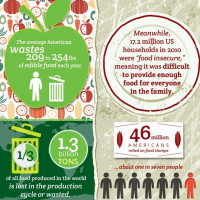How often do you find yourself throwing away wilted greens or leftovers that have sat too long in your refrigerator? Probably a lot, according to a new report by the Natural Resources Defense Council (NRDC) entitled “Wasted: How America Is Losing Up to 40 Percent of Its Food from Farm to Fork to Landfill.” On average, people in the U.S. throw away 20 pounds of food each month, which amounts to an annual loss of $1,350 and $2,275 for the average family of four.
But it’s not just consumers that contribute to the staggering 40 percent of food that is wasted in the U.S. Waste-related inefficiencies across the supply chain- at the farm, during processing and distribution, and in retail and restaurants – are costly for businesses. For example, Stop and Shop/Giant Landover, a $16 billion grocery chain, saved an estimated annual $100 million by reducing shrink (waste) and improving customer satisfaction through a redesign of their perishables department. Food. University of California-Berkeley food service used LeanPath software to reduce their kitchen food waste by 43 percent, saving them over 1,000 pounds of food and $1,600 weekly. One farmer who was not able to sell 70 percent of his carrots because of their irregular shape, found that he could sell them all, and for $.50 per bound compared to .$17 a pound, by cutting them into “baby carrots.”
The report takes a hard look across the supply chain at the areas generating most waste, using the best available data, and makes a number of recommendations for waste reducing solutions.
One example of a tech-related problem and solution referenced in the report was that of rejected perishables at the distribution stage. Perishable items can be rejected if they do not meet the requirements of a buyer, at which point the distributor must find a new buyer. By the time these items make their way to a new retailer, they have a shorter shelf life. Often times, they are just dumped. The report suggests a need for an online exchange to find markets for reject products, but cautions that distribution “offers limited opportunities for increased food efficiency.”
There are a number of problems in need of technical solutions. Check out the report for a full summary of the causes and potential remedies.






